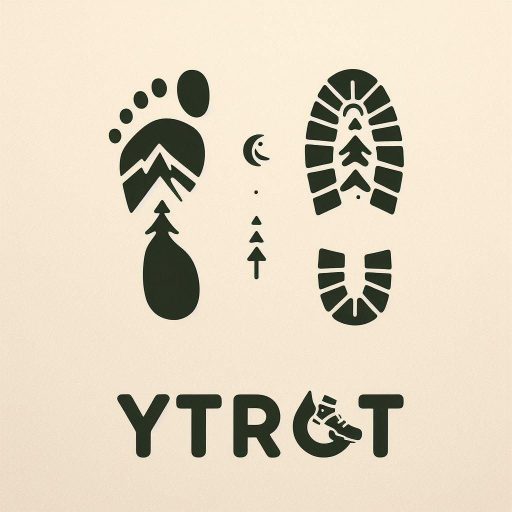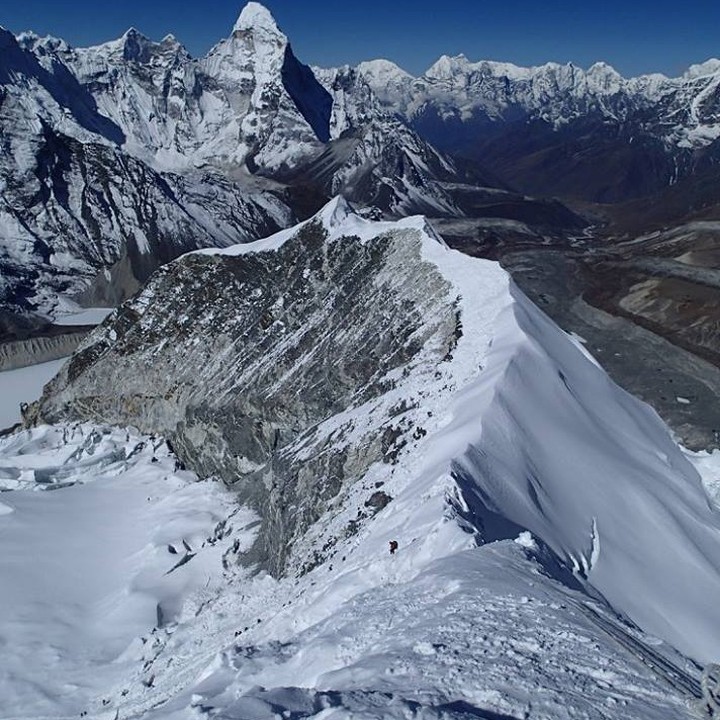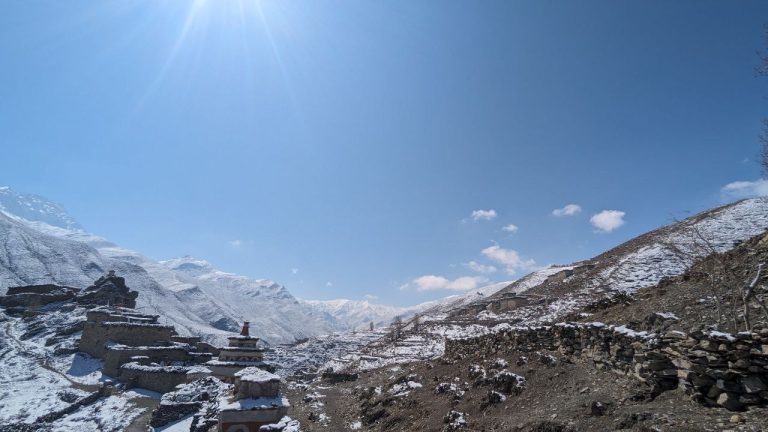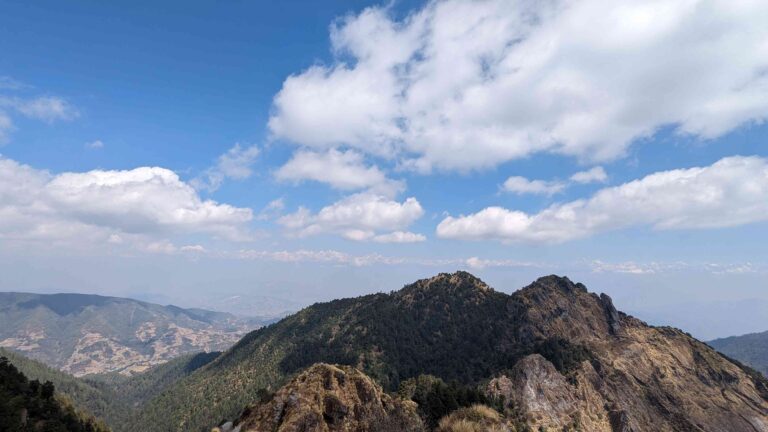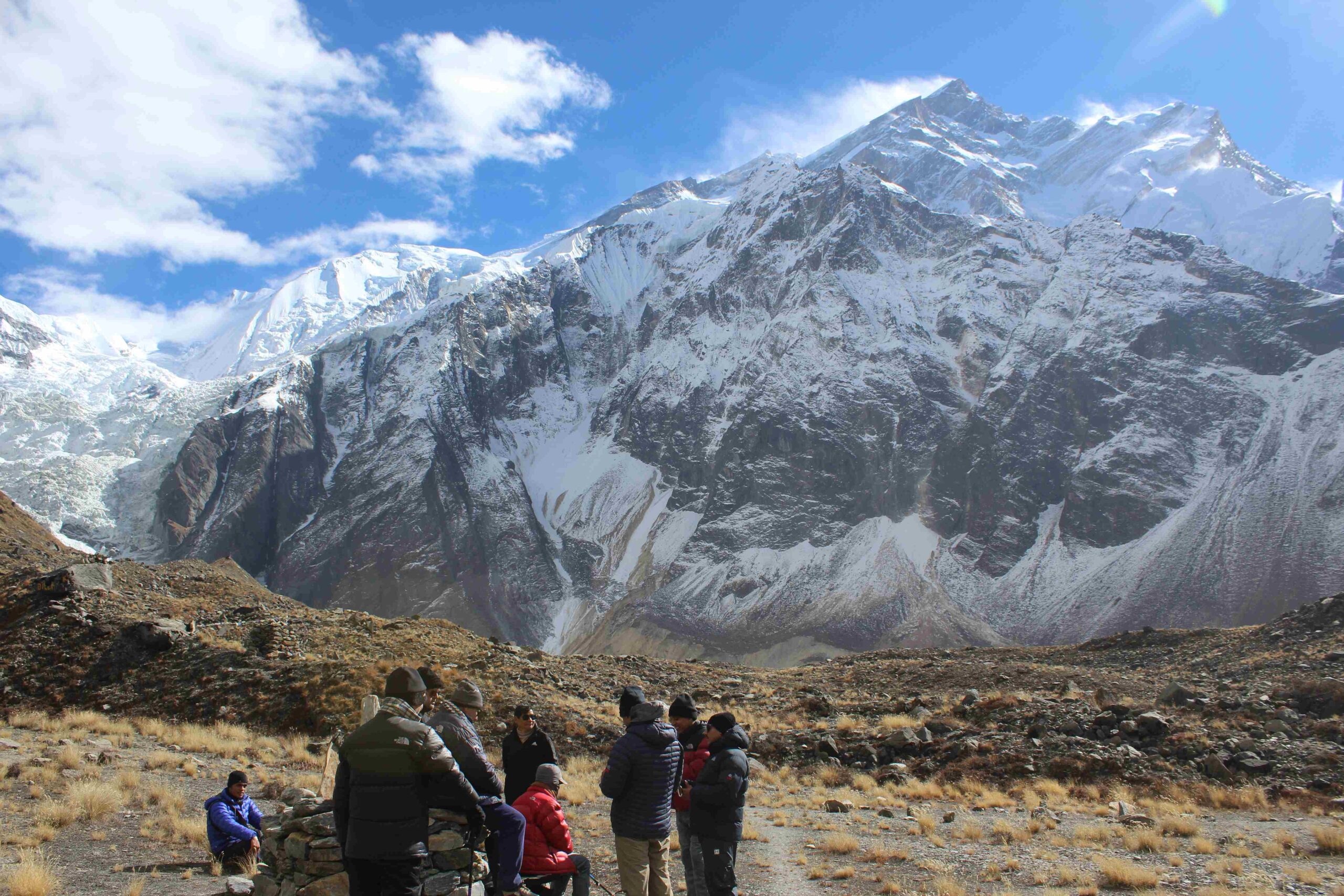Imja Tse, often referred to as Island Peak, is one of the most popular summits for beginner mountain climbers because it is over 6189 meters high. Although scaling a mountain is no easy task, Imja Tse, Island Peak is one of the easier peaks to summit due to its lower elevation compared to other Himalayan giants. Island Peak towers over the Imja Glacier and Lhotse Glacier, and Lhotse Shar ridge in the Imja valley in the Everest Region.
Members of the British Mount Everest expedition gave the mountain the name Island Peak in 1953 because, as viewed from Dingboche, it looks to be an island in a sea of ice. Imja Tse is the local name of the peak, however Island Peak is still the most widely used.
The path to Island Peak follows a steep slope and across a curvy ridge. In Dingboche and Namche Bazaar, limited climbing equipment can be rented; however, Kathmandu offers a larger variety. The Nupste, the south face of Lhotse, Makalu, and the elegant pointed peak of Ama Dablam can all be seen from the summit of Island Peak, as well as a stunning vista of the Chukhung valley and neighboring Khumbu peaks.
How to Reach Imja Tse (Island Peak)?
To get to the mountain, there are no motorable roads. From Kathmandu, you can either take a flight to Lukla or take a long hike from Jiri or Salleri. The popular Everest Trek trail leads from Lukla to Dingboche, where you can take the straight route to Chukkung. Chukkung is only a little more than six kilometers from the Island Peak Base Camp. From base camp, you attempt the summit. If you want to camp in high camp, climbing Island Peak and returning to base camp or Chukkung only takes one or two days.
Short Itinerary of Imja Tse (Island Peak)
| Day | Activity | Altitude | Time |
| Day 1 | Arrival at Kathmandu | 1400 m | – |
| Day 2 | Explore Kathmandu Valley and Preparation | 1400 m | – |
| Day 3 | Mountain Flight to Lukla, Trek to Phakding | 2610 m | 35 mins flight, 3 hours trek |
| Day 4 | Trek from Phakding to Namche | 3440 m | 7 hours trek |
| Day 5 | Acclimatization Day and Explore Namche | 3440 m | – |
| Day 6 | Trek from Namche Bazaar to Tengboche | 3860m | 6 hours trek |
| Day 7 | Trek from Tengboche to Dingboche | 4410 m | 6 hours trek |
| Day 8 | Trek from Dingboche to Chukkung | 4730 m | 4 hours trek |
| Day 9 | Trek from Chukkung to Island Base Camp | 5200 m | 5 hours trek |
| Day 10 | Ascend Island Peak Summit and Back to Island Base Camp | 6189 m | 9 hours ascend and descend |
| Day 11 | Contingency Day | – | – |
| Day 12 | Trek from Island Base Camp to Pangboche | 3985m | 6 hours trek |
| Day 13 | Trek from Pangboche to Namche Bazaar | 3440 m | 6 hours trek |
| Day 14 | Trek from Namche to Lukla | 2840 m | 6 hours trek |
| Day 15 | Fly back to Kathmandu | 1400 m | 35 minutes flight |
Detailed Itinerary of Imja Tse (Island Peak)
Day 1: Arrival at Kathmandu
You will take a shuttle to your chosen hotel following your at Kathmandu’s Tribhuvan International Airport. You will learn more information about the trip and expedition. Additionally, you will also meet with your tour guide. You can visit Thamel, the main tourist destination in Kathmandu, which boasts a thriving nightlife.
Day 2: Explore Kathmandu Valley and Preparation
You take the day off to rest and explore. Regarding historical and cultural diversity, the Kathmandu Valley has a lot to offer. 8 UNESCO Word Heritage Sites can be found in the Kathmandu Valley. You may see the elaborate architecture of the former Malla dynasty by visiting the historical palaces in Hanuman Dhoka Durbar Square, Patan Durbar Square, and Bhaktapur Durbar Square. Hinduism and Buddhism, two of the most prominent religions in the world, converge to a unique apex in the Kathmandu Valley. PashupatiNath temple, one of the largest Hindu sacred sites, is a must-see for any travelers. Similar to this, Swambhunath (Monkey Temple) and Bouddhanath are also two of the most important monasteries for Buddhists.
You then get ready for your excursion to the Himalayas, which starts the following day.
Day 3: Mountain Flight to Lukla, Trek to Phakding
The expedition begins with a 35-minute scenic mountain flight from Kathmandu to Tenzing-Hillary Airport in Lukla (2840 m). The airport in Nepal with the highest elevation is Lukla.
After registering for an entrance card at the Lukla Tourism Checkpoint, your journey to the Himalayas will begin.
The trail then formally begins as it enters via the Pasang Lhamu Sherpa Memorial gate and crosses the Dudh Koshi River on a suspension bridge. The route continues to the first destination of the trek, Phakding, which features a breathtaking display of prayer wheels, mantra-painted Mani stones, and holy monasteries. Reaching Phakding village requires a three-hour uphill trek.
Day 4: Trek to Namche
Although it is a lengthy and exhausting trek, the road to Namche is so delightful. The route from Phakding goes via a number of Sherpa villages, including Rimijung, Zamfute, Benkar, and Chhamuwa. When you reach Monjo village, the Sagarmatha National Park’s border, you will have ascended through a spectacular forest of fir and rhododendron. Before proceeding, turn in your admission card and your park entry card. The trial moves forward from Monjo over the Tenzing-Hillary suspension bridge across the Dudh-Koshi River in Jhorsale Village, which is the junction of the Dudh-Koshi and Bhote-Koshi rivers. In Namche, the busiest tourist destination in the Everest region, the day comes to an end.
Day 5: Acclimatization Day and Explore Namche Bazaar
You acclimatize for a day in Namche Bazaar. The village is home to a wide variety of stores selling a variety of goods, eateries, bakeries, and both affordable and luxury lodges.
For an acclimatization hike, you ascend to Shyangboche, which is above Namche, and visit Hotel Everest View, a well-known vantage point in the Everest region. Before going to Khumjung, a historic Sherpa hamlet, take in up-close views of Ama Dablam, Lhotse, Nuptse, Mount Everest, and Thamserku from the hotel’s terrace.
At Namche, replenish your energy and conserve it for the remainder of the expedition. Please refrain from drinking beer, wine, or other noxious beverages while adjusting to the altitude in Namche.
Day 6: Trek to Tengboche
The trail from Namche climbs steadily for a few hours via a Sherpa village called Kyangjuma. Walking through a thick juniper forest you arrive at Sanasa, a junction in the path where Gokyo Lake and Everest Base Camp split off to the left and right, respectively. The trail then descends to the settlements of Lawichasa and Tashinga via a thick juniper forest while providing a magnificent view of the towering peak Ama Dablam. Then descend to Phunki Thanga, a lovely settlement that offers a great view of a row of residences next to the Dudh Koshi river. We travel from Phunki Thanga to Tengboche on foot for about two hours through a towering, dense rhododendron forest with suspension bridges. Stay at a lodge in Tengboche for the night.
Day 7: Trek to Dingboche
The trail from Namche climbs steadily for a few hours via a Sherpa village called Kyangjuma. Walking through a thick juniper forest you arrive at Sanasa, a junction in the path where Gokyo Lake and Everest Base Camp split off to the left and right, respectively. The trail then descends to the settlements of Lawichasa and Tashinga via a thick juniper forest while providing a magnificent view of the towering peak Ama Dablam. Then descend to Phunki Thanga, a lovely settlement that offers a great view of a row of residences next to the Dudh Koshi river. We travel from Phunki Thanga to Tengboche on foot for about two hours through a towering, dense rhododendron forest with suspension bridges. Stay at a lodge in Tengboche for the night.
Day 8: Trek to Chukkung
Today, we proceed to Chukkung. Even though the distance between Dingboche and Chukkung is only a short walk, we can feel the altitude. Enjoy the enticing vistas of Makalu, Island Peak, Lhotse, and Chukkung Ri as you hike. Then you go through Chukkung’s neighborhood and breathe in the thin air of this high altitude. We stop moving forward to give our body time to gradually acclimate. You can explore the surroundings around the settlement, or you can unwind at your lodge and gaze at the mountains from the porch.
Night at Chukkung Teahouse.
Day 9: Trek to Island Base Camp
After a short distance of walking in the direction of Chukkung, we begin to ascend through the Lhotse Glacier’s created moraine. We arrive at Island Peak Base Camp next to Imja Glacier and Lhotse Shar Glacier after a short amount of time spent traveling in the opposite direction of the Imja Tse.
We require food, water, tents, and other necessities to be transported to Base Camp because there are no tea houses or lodges there. After lunch, go to a pre-climb training session. Under the watchful supervision of your guide, you will be able to hone your rappelling and belaying techniques here. Along with that, he will show you how to use a harness, ice axe, karabiner, ascender, etc.
Overnight at a tented camp.
Day 10: Climb Island Peak and Back to Base Camp
To gain a head start and get ahead of schedule, start right after midnight. To avoid the clouds and strong winds that sweep in the afternoon, you must start climbing the slopes as quickly as possible.
You arrive at High Camp after a little hiking. The ascent to Crampon Point from here takes about three hours. The trail becomes ice and treacherous, so you don your crampons. As soon as the crew reaches 5700 meters, man-ropes will be tied for their protection. Reach the base of Imja Glacier by following a short ridge. From the glacier, you may see Makalu, Ama Dablam, Mera Peak, Chamlang, and other peaks in a stunning sunny vista. The hardest part of the hike involves climbing a steep wall before reaching the summit. By fastening and unfastening your harness on the fixed line, you must ascend past the anchor points.
The crevasses will be traversed using a ladder. Till you reach the summit, stick to the ridgeline. Spend some time at the summit capturing pictures and taking in the beautiful vistas.
You quickly descend to the base camp after that. Spending a lot of time at the summit can cause nausea and altitude sickness, so it is not advised. It’s a protracted decline. Keep an eye on your footing. Once you get at the base camp, take some time to relax and enjoy your accomplishment.
Day 11: Contingency Day
If inclement weather prevents you from reaching the summit on the scheduled day, add an extra day. You can also utilize this day for situations like travel delays or cancellations, weather-related delays, etc.
Day 12: Trek Back to Pangboche
We descend to Dingboche while enjoying the spectacular vista of Lhotse on the right and Ama Dablam on the left. From here, the trail descends alongside the Imja River and offers serene surroundings and dazzling snow-covered massifs. Following parched terrain and jagged stones, we descend towards Somare and finally Pangboche after passing the suspension bridge ahead of Orso. Today’s lodging will be in the village of Pangboche.
Day 13: Trek Back to Namche Bazaar
You’re heading to Namche Bazaar today. Following the villages of Milingo, Debuche, and Tengboche, we cross a suspension bridge and descend to Phunki Thenga. The trail twists and turns and halts at Sanasa, a fork from which the trial departs to Gokyo Lake, Khumjung Valley, or Khyangjuma village, with a spectacular view of the water-driven prayer wheel from the suspension bridge.
At Namche, you can now enjoy the luxuries you had been lacking for the past few days, such as hot showers, flavorful meals, excellent coffee, baked goods, etc.
Stay the night in a teahouse in Namche.
Day 14: Trek Back to Lukla
We descend along the DudhKoshi River, passing through the Sherpa villages of Phakding, Nurning, Ghat, Thadokoshigaon, Cheplung, and Thalsharoa, crossing suspension bridges at Chhamuwa and one before Bengkar village. We travel to Lukla from the intersection of Thalsharoa for comfortable lodging.
Day 15: Fly back to Kathmandu
Your expedition ends here with a flight back to the capital city of Kathmandu.
How Difficult is it to Climb Island Peak?
Despite not being particularly challenging to climb, Island Peak can be physically demanding. Before moving on to anything more challenging, it is the perfect mountain for beginning climbers to conquer. It is also the ideal Himalayan peak for climbers who are attempting their first Himalayan peak summit. They gain the extra confidence from utilizing ropes to belay and rappel down on Island Peak and climbing on ice, rock, and snow with tricky moves.
It is all part of the adventure to walk safely on a man rope through glacial terrain, but prior knowledge is undoubtedly helpful. On the headwall, you will need to ascend using a jumar and safety karabiner fastened to your harness and descend using a descender.
Although the crevasses are not particularly large and manageable, navigating ladders can be unsettling. However, some people find it challenging despite the handrails that are fastened to snow pegs in the ground. Some people decide to cross on their hands and knees, even though using crampons that are put across the ladder’s rungs is the ideal alternative.
